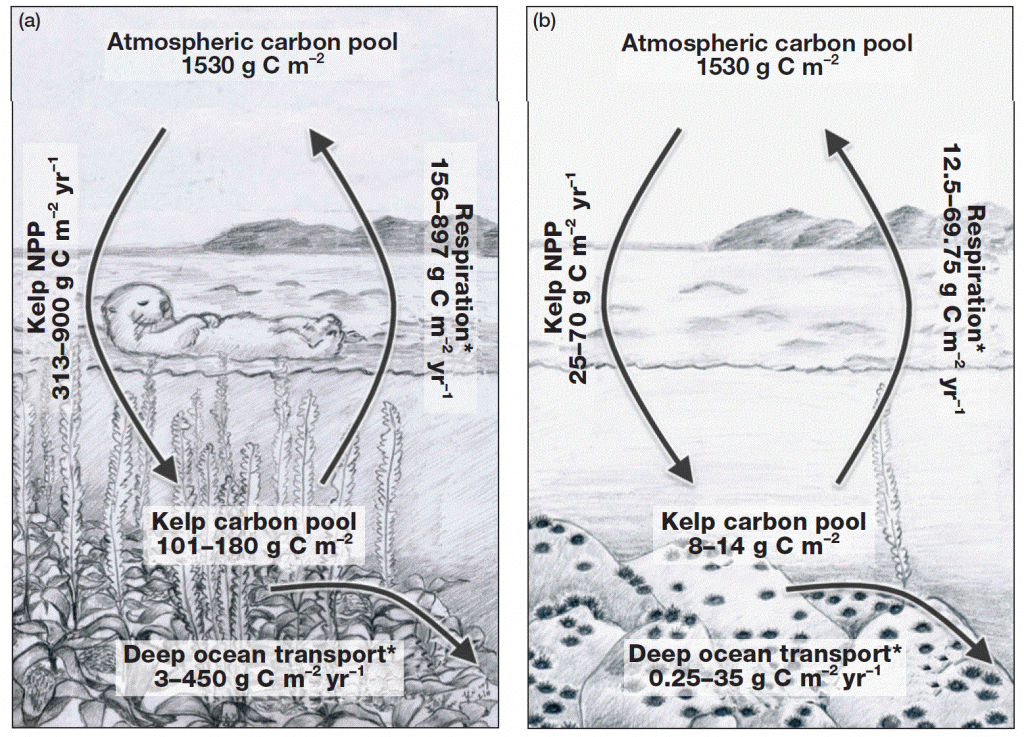In a new paper in the journal Frontiers in Ecology and the Environment, Chris Wilmers and colleagues examine how much carbon is stored (in the form of kelp) in North Pacific coastal ecosystems which either have or lack sea otters. In the absence of sea otters, sea urchin populations increase and graze kelp forest to form urchin barrens. Wilmers’ results suggest that sea otters can substantially alter ecosystem carbon budgets through their indirect effects on plants. They hypothesize that predators can strongly influence the carbon cycle in general and atmospheric carbon dioxide through top-down forcing and trophic cascades. Although the authors caution that the extent to which these effects can be extrapolated across species and global ecosystems remains to be determined, they suggest that, because predators exert strong indirect effects on plants in many ecosystems, these effects might appreciably influence the concentration of atmospheric carbon. The effects of trophic cascades on carbon flux and storage also have an economic dimension, given that the value of increased kelp carbon standing stock due to sea otters would be valued at between 205 and 408 million dollars on world markets for carbon credits.
The authors suggest that the degree to which predator effects in other ecosystems would substantially influence atmospheric carbon dioxide concentration will depend on three factors: the overall influence of predators on autotrophs through trophic cascades across global ecosystems; food chain length and the resulting degree to which the trophic cascades have a positive or negative influence on associated plant populations; and the standing plant biomass and NPP for each particular ecosystem. They propose that we should expect predators in food webs with odd numbers of trophic levels to reduce atmospheric carbon (via increased sequestration by plants), while predators in food webs with even numbers of trophic levels might increase atmospheric carbon. They conclude “This influence alone complicates the assessment of predator effects on carbon in aquatic systems because food chain length varies considerably among aquatic systems. Large predators in most terrestrial ecosystems occupy the third trophic level, thus implying a more consistent sequestering effect of predators on C for the terrestrial realm. However, terrestrial ecosystems are rife with other complexities such as predator interference, omnivory, and defended plant tissue that make it difficult to form general conclusions about the magnitude of such effects.”
This new study is important in focusing attention on the ecosystem effects of predator restoration. However, proposals to monetize the effects of predator-prey dynamics on ecosystem carbon storage raise ethical questions. For example, although in parts of the developed world, ungulates are superabundant due to predator removal, in other regions, ungulate abundance and distribution has been reduced below historic levels by over-exploitation. Would recovery of these prey populations be opposed due to the effects on carbon storage?

Figure from Wilmers et al. 2012. When occurring at ecologically effective densities, sea otters reduce sea urchins, resulting in large kelp standing stocks and high net primary productivity (NPP). (b) When sea otters are absent, urchins decimate kelp stands, resulting in small kelp standing stocks and low NPP.
